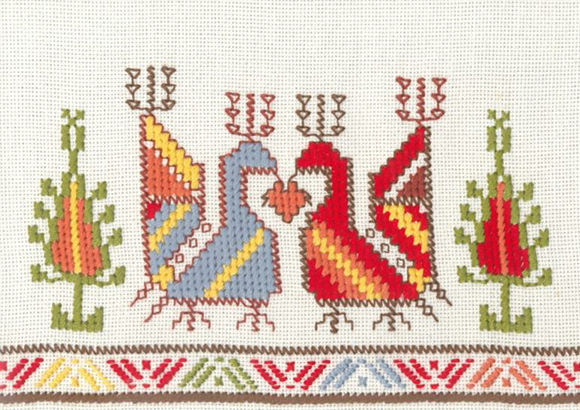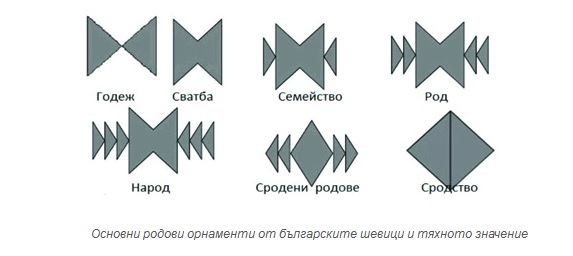THE BULGARIAN NATIONAL EMBROIDERY- PROTECTION AND PLEDGE WITH BEAUTY

The Bulgarian embroidery, as an element of the folk art, carries the mark of the richness of our national folklore. The embroidery in the traditional Bulgarian costumes is a testimony of cultural virtues and achievements. Extremely varied in terms of elements, the embroidery is an expression of richness of soul, artistic and creative talents, and a constant pursuit of beauty and grace.
The creative process of this folk art is an expression of our national spirit and the pursuit of spiritual uplifting. The embroidery shows the position of the Bulgarian woman in society, her morals and the view of the world.
The symbolism of the Bulgarian embroidery is expressed by the colors and figures used for its creation. It is a combination of the symbolism of protection of the family and the pledge for prosperity of the family.
The main colors used are red and green, usually on a white background.
The red color, which is a symbol of the mother’s blood and the sequel of the genus, plays the role of a protective talisman against enchantment and jealousy, protects against “bad eyes”. A number of beliefs and customs are associated with it: the first Easter egg is painted in red; the bride wore a red veil; red thread is tied to the newborn, red is also one of the colors of the martenitsi.
The green color is perceived as an expression of the reviving life and is connected with the Tree of Life which gives eternal life and healing. The close relationship between man and nature is embodied by this color.
The white color symbolizes purity, impenetrability, and the divine light. Traditionally, when getting married the bride stood on white wool, she span white wool for the wedding ceremony, the “silent water” was poured in white buckets for the ritual breads for the wedding.
Gold also has its participation in the embroidery. It is a symbol of Fire and Light, of the Sun, and consequently of the prosperity of people. It is no accident that the girl from the folk tale is immersed in a golden river.

(picture: Petya Veleva, Lina Jordanova, Gabriela Kiriakova, Nadajda Angelova, article: The sicret language of bulgarian embroidery)
The figures, though quite varied, are mainly based on several geometric shapes. The leading one is the rhombus. The rhombus in the traditional women costume is displayed on the apron as a symbol of fertility. Worn by young brides it means that they can now participate in the reproduction of the genus. Rhomboid elements are also embroidered on the bosom, sleeves, and skirts- the parts of the female body with sexual symbolism.
In the men’s costume, we again find rhombus-shaped elements embroidered on the top of the shirt. They emphasize the desire for fertility.
Even while weaving and sewing her cheiz, the future bride puts in it the vows towards her family members and her future husband. In her gifts she enweaves the figures of Makaz, Kanatitza and Babica.
The Makaz is composed of two triangles and symbolizes engagement. In this symbol the triangles touch with their vertices, but their merging occurs in the Big Macaz. It expresses the marriage, the sacred unity of the spouses as future parents. Added to the Big Makaz on both sides, small triangles convert it to Kanatitza – a symbol of the accomplished offspring, ie the main purpose of the created family was realized – children were born. Expanding this symbol by adding another small triangle to the sides turns it into the Big Kanatitza, embodying the genus, ie. the first generation already has its heirs. When the triangles on both sides are already three, this is now the People- the Great Kanatitza.
The Babica is a symbol of the now related families. The main, central element is the rhombus – the female beginning, but it is made up of two adjoining triangles expressing kinship. Here the added triangles are now pointing outwards, suggesting leaving the family knee and joining another.
The traditional costume was a sign of the social status of the person wearing it. On it are embroidered the elements that symbolize his social status.
Folk art is not just the national art, but a transfer of the family memory and ancient knowledge inherited through cultural traditions. The embroidery is one of the most brilliant achievements of this art.
Nowadays, this art is neither forgotten nor neglected, and is not only a part of the costumes of dancers or singers of folk ensembles. On the contrary, this art has penetrated in the city life through the embroidered tablecloths and towels which gradually acquire citizenship. We find it on jewelry boxes or other small objects of the city life.
The weaved motives are found in the kitchen aprons and towels, utensils such as napkinsi. Today, they are even an element of the modern urban person’s clothing, though more simple and mainly on shirts and blouses.
Passed through the centuries is a stylized image of the turtle – the embroidery, which we often see as ornamentation in costumes and clothes or on jewelry. This symbol of infinity was worn even by the ancient Bulgarians as a protective talisman against misfortunes.
Over time, the embroidery has lost the meaning of a sacral element. Although largely stylized and transformed in its infinite diversity, it represents a unique heritage of the secret language embedded in the ornaments, a memory of the rich worldview of the Bulgarian woman, and the incredible feeling of rhythm, harmony and beauty.
—————————
The published materials are the result of a study by Veronika Ivanova, presenting Irene Jamami, who has been living in Japan since 1988, where her love for embroidery from all over the world inspires her to create an embroidery school where she teaches until now. She wrote the books “ACHAIK CYMBOLS in BOPDOIRYA” for symbolism in the embroidery of the embroidery and “Bulgaria in embroidery” containing 140 embroidery from the whole country, emblazoned on the map of Bulgaria
The images are not used for commercial purposes but only as illustrative material. All of them are freely existing in the network on the principle of sharing or the rule of the cited source.
